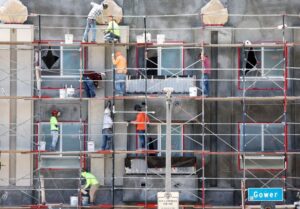Finding California housing has become quite a challenge; some even say it’s a crisis. The Golden State is suffering from not enough homes, despite the exodus and new construction. What is the problem? It’s probably not what you think.
Obstacles to California Housing
The California Association of Realtors’ latest affordability index shows that the state has dropped to the 2007 pre-Great Recession levels. “Today, just 16% of California households can afford the median home for sale in the state, compared to the national average of 36%,” reported The Center Square. Reasons that first come to mind for this problem may be the influx of illegal immigrants, rampant homelessness, and the high cost of living — but other factors are at work.
The state has “restrictive zoning codes that favor existing homeowners over potential new residents, lengthy lawsuit-laden approval processes, soaring costs for construction and land, and a shortage of available workers to build,” Vox explained.
It makes sense that one way to reduce the cost of housing is to build more homes. To that end, Democratic Gov. Gavin Newsom set a goal to build 2.5 million homes by 2030, which is about 312,500 per year. In November 2022, he said in a newsletter, “Understanding that we have no time to waste, in just one year, the Housing Accountability Unit has moved with a fierce intensity to break the status quo and remove bureaucratic roadblocks.”
However, as The Center Square pointed out, “in its first year of operation, the Housing Accountability Unit, part of the California Department of Housing and Community Development, helped complete just 1,700 of the 3,500 CHD-involved units that year, a drop in the bucket towards the state’s housing goals.”

(Photo by Mario Tama/Getty Images)
So why is the government unable to meet the target? One troublesome obstacle is the carpenters’ unions. Lawmakers have faced difficulties for the past decade whenever they tried to pass new legislation to increase the California housing stock. Obviously, unions want more job opportunities, but they also want to guarantee the work is completed by unionized laborers, which involves higher pay and benefit packages. But most of the state’s construction workforce are not union members.
And then there is the issue of prevailing wages in a state that has such a wide range of pay requirements. For example, why should the Central Valley, which is mostly agricultural with much lower income and a high number of welfare recipients, pay the same rate for public works jobs as the bigger cities along the coast?
Another roadblock is the California Environmental Quality Act, passed in the 1970s, which ensures construction projects must accommodate in their plans issues of air quality, noise, and natural resources. Court challenges against large building ventures — commonly mounted by NIMBYs, the “not in my back yard” folks — have blocked or delayed new housing. “Today, it’s typical for a proposed housing project to face at least three or four years in court battles, with added costs in the hundreds of thousands or even millions of dollars,” Vox wrote.

(Photo by Tayfun Coskun/Anadolu Agency via Getty Images)
Change in Demographics
Another interesting theory highlighted by Hans Johnson, a senior fellow at the Public Policy Institute of California writing for CapRadio, suggests a big part of the problem is changing demographics in the state. “For the first time ever, the state is losing population,” Johnson explained. “And it’s kind of a perfect storm of demographic events that have led to that. We have the lowest birth rates ever recorded in our state.” Add to that pandemic-associated deaths and a climbing death rate based on California’s aging population.
Johnson explained that residents are spreading out, with fewer people living in more housing units. The reason for this:
“People are having fewer children, so of course that leads to a decline in the number of people in a household. The population is aging. And older people, especially seniors, are more likely to live alone or with just one other person. But we see that roommates, who prior to the pandemic might have had two or three roommates, are now having fewer roommates and spreading out that way.”
Johnson noted that the type of California housing being built now likely contributes to the decline in the number of people living in units:
“Specifically, we’re building a lot of multi-unit housing – large buildings with five or more units per building. And the number of single-family detached homes that we’re building in California is actually declining.”
Residents of the Golden State can look forward to expensive bond measures that might appear on March and November 2024 ballots to stimulate building projects:
- $10 billion proposal for the March ballot would “replenish the coffers of some of the state’s premier affordable housing programs,” wrote Cal Matters. If voters approve of this, “it would be the largest housing-related IOU that California has issued since at least 1980.”
- $4.68 billion backed by Newsom, also for the March ballot, to build housing and expand psychiatric and substance abuse treatment for the homeless. If approved, it would be the “largest-ever expansion of behavioral health funding” for the state, and as a housing-related bond, “it would also be the third largest such measure in recent memory.”
- The Bay Area Housing Finance Authority is still figuring out how much money to request to build affordable housing across the nine counties surrounding the San Francisco Bay, perhaps in time for the November 2024 ballot. It could be as much as $20 billion, warned Cal Matters.
Is three of the largest housing bonds in the state’s history hitting voters in a single year a good idea? It will be interesting to find out.




